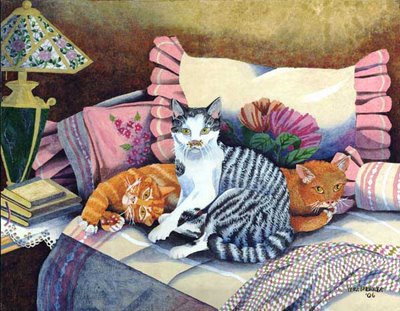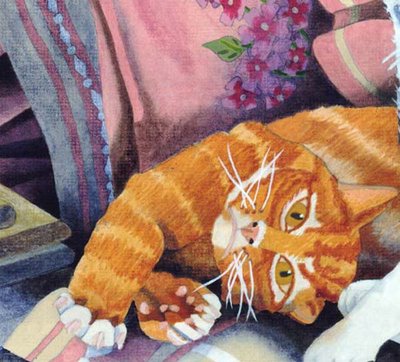
No, I am not planning to laboriously show each and every painting as it's produced. In fact you may correctly deduce that, since this post is dated in March, and the previous one had been in January, there may have been one or two, or three (okay, probably more like four) paintings developed and completed between. However, there are some areas pertaining to this watercolor-style-acrylic painting I would like to point out.
First of all, notice how nicely the flowers on pillows tuck neatly behind the cat bodies. No big deal right . . . Right. No, I really am serious; there is no trick to that part at all! But, the wonderfully transparent blue-grey glazing applied over the flowers is what I want you to see. Until experimenting for myself, I would never have believed such a sheer luminous passage (easy with transparent watercolor), could be accomplished with acrylic as well. Looking further over the painting, I hope you will notice many more places where this type of glazing and shading were used; usually in areas of shadow.
 In this second image, besides getting a good look at my favorite cat friend, I hope you can see the grainy surface in the upper left hand corner. The paper grain has been enlarged here as well. The use of watercolor paper, in this case Arches Cold Press 140 lbs., is largely the reason for any ease of handling. When being used over a gesso, I have not found that same willingness to glaze and blend that acrylics have when used with paper.
In this second image, besides getting a good look at my favorite cat friend, I hope you can see the grainy surface in the upper left hand corner. The paper grain has been enlarged here as well. The use of watercolor paper, in this case Arches Cold Press 140 lbs., is largely the reason for any ease of handling. When being used over a gesso, I have not found that same willingness to glaze and blend that acrylics have when used with paper.I hope by showing these paintings some of you will want to give acrylics a try. They truly have several advantages over watercolor not readily apparent. One is the ability to freely use mask without disturbing any color below. For instance, I found mask very handy when moving from light colored pillow fabric into the much darker background, still keeping a clean line. Something I would not have done if using watercolor for fear of leaving a pale line where mask was removed. Yet, to the busy artist, this ease of movement can offer a significant advantage.
And acrylics do not have the correction limitations of traditional watercolors. In the previous post I mentioned the many tries needed to repaint one specific area of "PLEASE" before finding the right look. Well, there wasn't anything quite as drastic with this painting, but there were a few areas of fur in need of corrections on the black and white cat. We all know what removing black paint would have involved if working with watercolor. All of the carefully dampened areas and repeated brushing of the dark painted paper until the entire top layer comes up. . . Sounds brutal even to type!
Acrylic requires only a few brushes full of white gesso to hide the offending black paint. . . Let the fresh gesso dry, then finish your corrections where needed.
